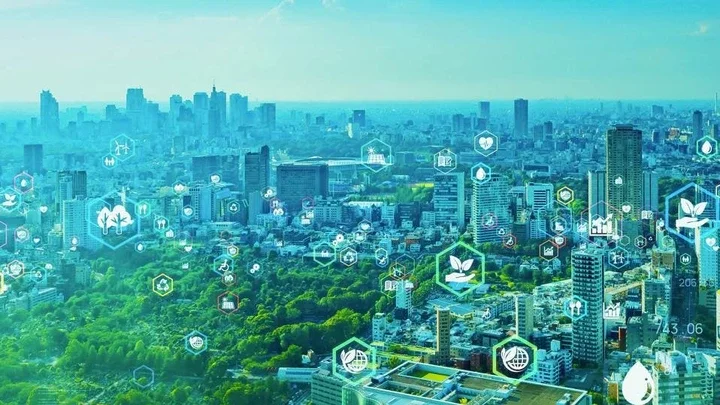
AI is quickly becoming one of the most powerful tools shaping how we live, work, and solve problems. Its influence touches everything-from personal routines to global systems. But like any transformative technology, it's not without trade-offs. For every breakthrough, there's a consequence. And for every solution, a new set of questions.
On one hand, AI has real environmental costs. Data centers demand enormous amounts of electricity. Training large models can consume as much electricity as thousands of homes use in a year. The carbon footprint of AI is measurable and only growing. These impacts are real. And they can't be ignored.
But on the other hand? AI also holds extraordinary potential. It may be one of the most powerful tools we have to confront the very environmental challenges it contributes to.
It can spot illegal deforestation from space. Track endangered species without setting foot in their habitat. Help to accurately forecast floods, wildfires, and pollution spikes before they happen. It can help us manage precious resources such as water, energy, and raw materials more efficiently and sustainably. And it can do all of this at a speed and scale we've never had access to before.
AI-powered monitoring for environmental protection
AI is starting to play a bigger role in how we observe, analyze, and respond to environmental change. Across various ecosystems ranging from dense rainforests to deep oceans, AI is helping us monitor the planet more precisely and take action more quickly.
For many years, efforts have been underway to try and save different species from extension. However, these efforts have traditionally been very manual, time consuming, and difficult. Now, conservation efforts are getting a major boost from AI. AI powered tools are able to analyze drone footage, camera traps, and satellite imagery to identify different animal species, estimate population sizes, and flag unusual patterns in movement or behavior.
These AI systems can even detect signs of poaching or habitat encroachment, allowing rangers and conservationists to intervene before it's too late. The result? Faster responses. less guesswork, and stronger protection for endangered species and fragile ecosystems.
Protecting land, air, and sea
Keeping the planet healthy means more than only protecting what we can see immediately around us. It requires real-time awareness of what's happening across forests, skies, and waterways. That's where AI is proving to be a powerful tool.
Forests just don't vanish overnight. It takes years of gradual degradation from illegal logging, land clearing, fires, and unchecked development. By the time the damage is visible to the human eye, it may be too late to reverse. AI is helping to change that. By continuously analyzing satellite imagery, computer vision systems can help detect subtle changes in land cover and can flag illegal logging, unauthorized land clearing, or unregulated mining in near real-time. Instead of discovering damage weeks, months, or years later, environmental authorities can now respond within hours helping to strengthen enforcement and preserve vital habitats before they're lost.
Air pollution is also dangerous, and in most cases much harder to spot with the human eye. By combining data from environmental sensors, emissions reports, and weather forecasts, AI models are able to predict pollution spikes before they happen. They can identify potential issues and recommend immediate interventions. For urban planners and city governments, these insights are turning reactive air quality management into proactive strategy.
Water is an essential element to life and unfortunately water scarcity is also becoming a pressing global concern. AI tools help address this problem by analyzing rainfall patterns, river flows, usage trends, and irrigation needs. AI systems can provide recommendations to optimize distribution networks, detect leaks, and forecast shortages long before they become crises. This ability to balance water supply and demand in real time, especially in drought-prone or agriculture-heavy regions, is helping communities manage water more sustainably and with greater precision.
From reactive to proactive: how AI helps predict and prevent environmental threats
Addressing a problem after it happens is one thing. But preventing it before it strikes? That's where AI shows its real power.
AI-driven climate models are able to analyze massive datasets that include satellite imagery, historical weather records, and real-time climate signals to generate forecasts that are not just more precise, but more adaptable. These models help scientists and policymakers simulate future scenarios, assess risks, and design more resilient strategies for a rapidly changing climate.
When it comes to renewable energy, AI is optimizing the way we harness nature's power. It predicts shifts in sunlight and wind patterns, helping energy providers balance supply and demand. Storage is fine-tuned. Grid loads are managed in real time. The result? Less waste, greater reliability, and a stronger foundation for scaling clean energy.
And when disaster looms, AI becomes a real-time decision engine. By analyzing satellite data, ground sensors, and even real-time social media feeds, AI can help better predict when floods, wildfires, and hurricanes will hit. This proactive approach helps with the communication, coordination, and response efforts allowing leaders to proactively notify communities in advance. From assessing potential damage patterns to mapping evacuation routes, these systems help emergency teams act faster, smarter, and often, save more lives.
AI is even helping in waste management. Computer vision systems can sort recyclables with far greater accuracy than manual methods, reducing contamination and boosting recycling rates. Meanwhile, predictive models estimate waste generation trends and help cities design more efficient collection routes cutting both costs and environmental impact.
While AI won't singlehandedly save, or destroy, the planet it's already proving to be one of our most powerful allies in the fight for a more sustainable future. AI is helping us see environmental challenges more clearly and act on them faster. But this power comes with responsibility. As we lean on AI to protect the planet, we must also ensure it's developed and deployed in ways that minimize harm, prioritize transparency, and center sustainability at every step.

















Comments